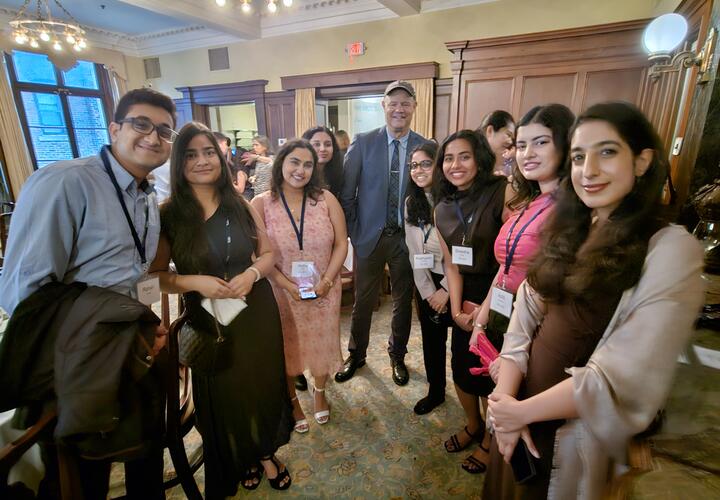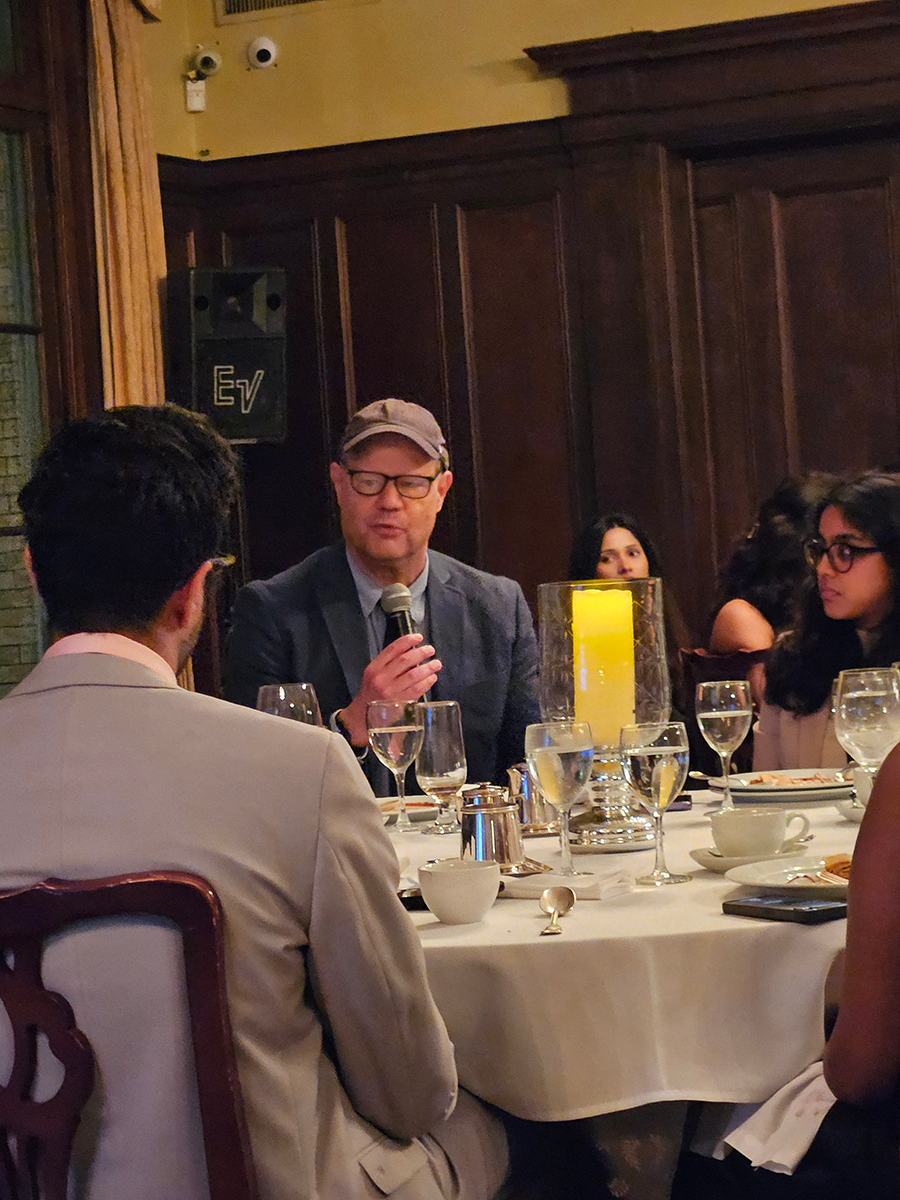IDE Director Mike Boozer reflects on the 70th anniversary of the program
At a 2025 reunion event, longtime IDE Director Michael Boozer spoke about the program's history. This is a transcript of his speech.

A brief history of the International and Development Economics (IDE) program
Tonight we celebrate the 70th anniversary of the IDE program. Twenty years ago, in 2005, I was about three years into my time directing the program, and we were celebrating the 50th anniversary. It was such a privilege because my predecessor, Robert Evenson was there.
That month of May in 2005, we lost Lloyd Reynolds at the age of 94. Lloyd actually set up the Economic Growth Center, which came after the founding of the IDE program. While I never had the privilege of meeting Mr. Reynolds, I have, in my time at Yale, become a serious student of his life’s work, as my colleagues can attest. Lloyd was an entrepreneurial academic who brought growth and development to Yale economics in both the metaphorical and literal sense.
He came to Yale after the war in 1945, and in 1951 (to 1959) he not increased the quantity of economists at Yale (the size of the Department doubled while he was chair), but also substantially increased the quality, including the hiring of some fellows by the names of James Tobin and Gus Ranis, who became the first Chairperson of the MacMillan Center for International Studies.
Lloyd Reynolds took a brief leave from Yale at the end of the decade at the Ford Foundation, and he managed to extract a $15 million foundation grant to start the Economic Growth Center at Yale, which he directed from its founding from 1961 to 1967. From the 1960’s until the end of the 1970’s, the Economic Growth center engaged in 25 “country studies” of LDCs via the Country Analysis Program, the results of which were published in a number of books sponsored by the Economic Growth Center.
But it was in 1952, a year after he became Chair, he was approached by Robert Triffin, himself newly arrived to Yale after stints at the Federal Reserve from 1942-1946, and the IMF from 1946 to 1949, and the European Payments Union, which helped found, from 1950 to 1951. (All this after a brief stint as an Instructor of Economics at a small liberal arts college in Cambridge – Harvard). Even after coming to Yale in 1951, Triffin kept one foot in the realm of public policy on international monetary systems and organizations and international economic cooperation with consultancies to the UN, OECC, and the EEC until his death in 1993.
Triffin’s background in international banking, currency, and the interlinkages of international currencies impressed on him the need to have young economists and staff statisticians employed in foreign currency organizations and central banks who were trained in post-Keynsian macroeconomics and monetary systems planning. But Triffin envisaged a two-way street whereby Yale scholars (staff and graduate students) would go to LDC countries and learn the systems on the ground.
While that second part of the flow never formalized, the IFEA program which was initiated by Triffin and enabled by Reynolds was widely considered a success by Reynolds and Tobin when reflecting on the IFEA program in the 1970s, by which point the program had trained 380 students from 77 countries. By that point, the largest number of students (49) were from Japan, followed by Mexico with 26.
The program was originally funded, like the Growth Center itself, with a grant from the Ford Foundation from 1955 until 1967, which provided partial funding for students. While the basic academic structure has remained largely the same, the program originally had stronger ties with the UN, the Federal Reserve, and the precursor to the World Bank for summer internships to get practical 2 months of additional training.
In 1969, Prof. Robert Evenson finally accepted an offer from the Department of Economics and the Economic Growth Center at Yale after obtaining a PhD from Chicago (he turned down an earlier offer in 1966, but he eventually saw the light). 1969 was also the first year Yale College began accepting women, and thus it marked a crucial turning point where the entirety of Yale became a more diverse (and competitive) institution. From 1955 to 1969, the IFEA program alone had trained nearly 250 men and women from abroad at the Master’s Level, and was highly innovative in that it provided a foundation for the globalization of Yale.
Bob took a leave from Yale to do field work in the Philippines to do field work from 1974 to 1977, including collecting panel data collection that has continued even past the year 2000. He returned to Yale with tenure in 1977, at which point he assumed the Directorship of the IFEA program.
In a fit of classic Evenson introspection, and perhaps a discussion or two, he renamed the “International and Foreign Economic Administration” program to the “International and Development Economics Program” reflecting his views on the redundancy of “International” and “Foreign” and replacing the archaic “Administration” from the Triffin central-banker and bureaucrat days to focus on development economics.
Under Bob’s tutelage and Directorship for the next 25 years, nearly 500 students obtained their degrees in the IFEA/IDE program, and the program solidified its position as a training ground for practioners in development economics and beyond
 Anna Groesser
Anna Groesser
IDE Co-Director Mike Boozer speaks about the history of the program during the 70th anniversary celebration.
A bridge to the present
That history relates to conversations I’ve had with lots of IDE students over the years about our role in this field. Look at the field of medicine. You need to have doctors. You need to have the people who are kind of hands on. You also need to have the very abstract fundamental science. And then you need to have the people that are doing the equivalent of the RCTs; clinical trials to evaluate new therapies, new pharmaceuticals, and so on.
It’s really great to have a program like IDE that isn’t just one pathway focusing on pre-PhD or policy-side or practitioner-side. What I’ve always told students weighing accepting their offer to come to the program is that you come to this program if you are comfortable having classmates who will take different paths than you.
What happens then is that we end up with a lot of students who are curious, and want to know more about those different pathways. That cross-pollination is good, and it shows in our alumni. The time in this program is ultimately very short, about 10 months at the school, but it does infuse a lot of what these alums end up pursuing and the types of topics that they take on.
But the other thing is that you may not figure out exactly what pathway to take while in the program, it may take a year or two. There are some alumni sitting here tonight that are still in the midst of that process. And I think that’s a great thing because once you do figure it out you have the tools to really grab hold of it and push through.
That’s something that we hear from our alumni who come back and talk to the students every year. The most important thing, like the world around us today, is that we’re having conversations with each other and we have respect for each other and we understand that we can learn a lot from listening to each other.
I think all of that started from these visionaries that thought that in the context of Yale University they could set up something where you didn’t need to be on a PhD track in economics to be a valuable member of the IMF or the OECD or an organization like that.
And so I feel very privileged to be a part of this continued evolution of the IDE program that started in 1955 as a public administration type of degree, and I feel privileged to see what all of the students go on to do with that opportunity.
To quote one of my favorite poets Bruce Springsteen, I feel so fortunate to “stand back and let it all be,” and see what all of you go and make it be.
 Anna Groesser
Anna Groesser
Current students and alumni gathered to celebrate the 70th anniversary of the IDE program.